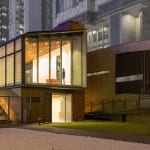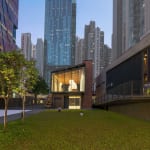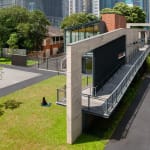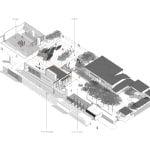









Phase II Development of Oil Street Art Space / Hong Kong
Further images
-
(View a larger image of thumbnail 1
)

-
(View a larger image of thumbnail 2
)

-
(View a larger image of thumbnail 3
)

-
(View a larger image of thumbnail 4
)

-
(View a larger image of thumbnail 5
)

-
(View a larger image of thumbnail 6
)

-
(View a larger image of thumbnail 7
)

-
(View a larger image of thumbnail 8
)

-
(View a larger image of thumbnail 9
)

-
(View a larger image of thumbnail 10
)


Urban Oasis
In the middle of Fortress Hill, a dense, mixed-use neighbourhood in Hong Kong, a historic yacht club was repurposed to become the Oil Street Art Space in 2013. Its red-brick, arts-and-crafts-style buildings house an exhibition space, the Government’s Art Promotion Office, and a multifunctional kitchen and lounge, as well as a lawn and garden that are suitable for large outdoor art installations and cultural events. The Art Space has what people expect from a modern museum, albeit on a smaller scale, including full programming with a mix of established and emerging artists from Hong Kong and abroad. However, unlike a museum, the Art Space is intimate and casual, and its outdoors and kitchen are also popular destinations for neighbours and office workers to meet up and relax in. Indeed, the Art Space’s location and accessibility are intended to bring art and creativity to everyday life.
Thanks to its popular success, the Phase II Development of Oil Street Art was conceived to add both indoor and outdoor spaces to the original premises. The original landscaping has been expanded to surround the new exhibition block. The concrete signposts and conduit frames are between inside and out. A ramp is built around them to lead visitors to the upper floor, which is enclosed by full-height glass walls on two sides, and glass bricks on the third. The glass allows natural light to flood into the exhibition gallery, and gives a clear view of the old yacht club, removing the boundary between the surroundings and museum so that passersby can see what is going on in the building, and perhaps decide to drop in.
Art Space and Connectivity
While the glass walls and concrete frames partition the space for different purposes and events, they also connect open spaces that were once the site of the government warehouse on the North Point waterfront. A plaza, timber deck, trees, trellises, and lawn all provide a multitude of possibilities. When the museum is open, several outdoor alleys, unlike the narrow pavements of the former industrial zone, lead to the nearby hotels and residential developments.
The extension sets an example in a densely populated city like Hong Kong, achieving multiple objectives in relation to revitalising the cultural heritage. This urban oasis was created to bring art and culture to where they are most needed: a living, breathing community that is home to ordinary people.

